Electricity Access Linkages to Sustainable Development Goals in Rural Sudan
Abstract
1. Introduction
1.1. Electricity System in Sudan
1.2. Energy Access and Development in a sub-Saharan Africa Context
1.3. Energy Access and Its Linkage to Sustainable Development Goals (SDGs) in Rural Sudan
2. Materials and Methods
2.1. Four Case Study Sites
2.1.1. Taebeen
2.1.2. Al Hashieb 2
2.1.3. Wiheishat
2.1.4. Helbeh Extension
3. Results
3.1. Health
3.2. Education
3.3. Gender Equality
3.4. Linear Regression of Independent Variables Influencing School Attendance by Gender
3.5. Multiple Logistic Regression of School Attendance by Gender
3.5.1. Multiple Logistic Regression of Boys Attendance to School
- chores = time required for household chores per day (hours)
- education level = adult respondent level of education
- income = stated household income, SDG per month
- number children = number children in household
- biomass collection = time required for biomass collection per day (hours)
3.5.2. Multiple Logistic Regression of Girls Attendance to School
- chores = time required for household chores per day (hours)
- education level = adult respondent level of education
- income = stated household income, SDG per month
- number children = number of children in household
- biomass collection = time required for biomass collection per day (hours)
3.6. Income Generation and Alleviating Poverty
4. Discussion
5. Conclusions
Author Contributions
Funding
Institutional Review Board Statement
Informed Consent Statement
Data Availability Statement
Acknowledgments
Conflicts of Interest
Abbreviations
| BOP | Base of Pyramid |
| HDI | Human Development Index |
| SDG | Sudanese Pound |
| SDGs | Sustainable Development Goals |
| GDP | Gross Domestic Product |
| LSMS | Living Standard Measurement Survey |
| SHES | Specialized Household Energy Survey |
| SHS | Solar Home Systems |
References
- UNDP HUMAN Development Report 2021/2022, Uncertain Times, Unsettled Lives: Shaping Our Future in a Transforming World. Available online: https://hdr.undp.org/system/files/documents/global-report-document/hdr2021-22reportenglish_0.pdf (accessed on 17 December 2024).
- ESMAP; The World Bank. From Subsidy to Sustainability: Diagnostic Review of Sudan’s Electricity Sector; Final Report; ESMAP: Washington, DC, USA; The World Bank: Washington, DC, USA, 2019. [Google Scholar]
- WorldBank. Electricity Access Data. Available online: https://data.worldbank.org/indicator/EG.ELC.ACCS.ZS?locations=ZG-SD (accessed on 10 December 2024).
- WorldBank. Population Data. Available online: https://data.worldbank.org/indicator/SP.POP.TOTL?locations=SD (accessed on 10 December 2024).
- Tiba, S.; Omri, A. Literature survey on the relationships between energy, environment and economic growth. Renew. Sustain. Energy Rev. 2017, 69, 1129–1146. [Google Scholar] [CrossRef]
- Stern, D.I.; Burke, P.J.; Bruns, S.B. The Impact of Electricity on Economic Development: A Macroeconomic Perspective, Center for Effective Global Action. In EEG State-of-Knowledge Paper Series; UC Berkeley: Berkeley, CA, USA, 2016; Available online: https://escholarship.org/uc/item/7jb0015q (accessed on 4 March 2025).
- Ateba, B.B.; Prinsloo, J.J.; Gawlik, R. The significance of electricity supply sustainability to industrial growth in South Africa. Energy Rep. 2019, 5, 1324–1338. [Google Scholar] [CrossRef]
- Trotter, P.A.; McManus, M.C.; Maconachie, R. Electricity planning and implementation in sub-Saharan Africa: A systematic review. Renew. Sustain. Energy Rev. 2016, 74, 1189–1209. [Google Scholar] [CrossRef]
- UN Publications. Commodities at a Glance: Special Issue on Access to Energy in Sub-Saharan Africa. 2023. Available online: https://unctad.org/system/files/official-document/ditccom2023d1_en.pdf (accessed on 4 March 2025).
- Rao, N.D.; Pachauri, S. Energy access and living standards: Some observations on recent trends. Environ. Res. Lett. 2017, 12, 025011. [Google Scholar] [CrossRef]
- Muner, S.E.T.; Mohammed, E.W.M. Adoption of biomass improved cookstoves in a patriarchal society: An example from Sudan. Sci. Total Environ. 2003, 307, 259–266. [Google Scholar] [CrossRef]
- Ghandour, D.A.M. Struggles for Electrical Power Supply in Sudan and South Sudan. In Proceedings of the Fifth International Conference on Advances in Economics, Management and Social Study—EMS 2016, Kuala Lumpur, Malaysia, 20–22 December 2016; pp. s40–s46. [Google Scholar] [CrossRef]
- McCollum, D.L.; Echeverri, L.G.; Busch, S.; Pachauri, S.; Parkinson, S.; Rogelj, J.; Krey, V.; Minx, J.C.; Nilsson, M.; Stevance, A.-S.; et al. Connecting the sustainable development goals by their energy inter-linkages. Environ. Res. Lett. 2018, 13, 033006. [Google Scholar] [CrossRef]
- Cabraal, R.A.; Barnes, D.F.; Agarwal, S.G. Productive uses of energy for rural development. Annu. Rev. Environ. Resour. 2005, 30, 117–144. [Google Scholar] [CrossRef]
- Bahaj, A.S.; James, P.A.B. Electrical Minigrids for Development: Lessons from the Field. Proc. IEEE 2019, 107, 1967–1980. [Google Scholar] [CrossRef]
- Hartvigsson, E.; Ehnberg, J.; Ahlgren, E.O.; Molander, S. Linking household and productive use of electricity with mini-grid dimensioning and operation. Energy Sustain. Dev. 2021, 60, 82–89. [Google Scholar] [CrossRef]
- FAO. Country Gender Assessment of the Agriculture and Rural Sector—The Republic of the Sudan; FAO: Rome, Italy, 2021. [Google Scholar] [CrossRef]
- UNDP. Empowering Sudan: Renewable Energy Adressing Poverty and Development. 2020. Available online: https://www.undp.org/arab-states/publications/empowering-sudan-renewable-energy-addressing-poverty-development (accessed on 14 February 2025).
- UN Women, Gender, Conflict and Environment Analysis in East Sudan. Available online: https://africa.unwomen.org/sites/default/files/2023-10/gender_conflict_and_environment_analysis_in_east_sudan.pdf (accessed on 14 February 2025).
- Omer, A.M. Renewable energy resources for electricity generation in Sudan. Renew. Sustain. Energy Rev. 2007, 11, 1481–1497. [Google Scholar] [CrossRef]
- Essendi, H.; Johnson, F.A.; Madise, N.; Matthews, Z.; Falkingham, J.; Bahaj, A.S.; James, P.A.B.; Blunden, L. Infrastructural challenges to better health in maternity facilities in rural Kenya: Community and healthworker perceptions. Reprod. Health 2015, 12, 103. [Google Scholar] [CrossRef]
- Harsdorff, M.; Bamanyaki, P. Impact Assessment of the Solar Electrification of Micro Enterprises of Health Centres. Available online: https://energypedia.info/images/d/d4/Impact_assessment_shs_preeep_uganda_2009.pdf (accessed on 17 December 2024).
- Herrin, A.N. Rural electrification and fertility change in the Southern Philippines. Popul. Dev. Rev. 1979, 5, 61–86. [Google Scholar] [CrossRef]
- Bahaj, A.S.; Blunden, L.; Kanani, C.; James, P.A.B.; Kiva, I.; Matthews, Z.; Price, H.; Essendi, H.; Falkingham, J.; George, G. The Impact of an Electrical Mini-grid on the Development of a Rural Community in Kenya. Energies 2019, 12, 778. [Google Scholar] [CrossRef]
- Kanagawa, M.; Nakata, T. Assessment of access to electricity and the socio-economic impacts in rural areas of developing countries. Energy Policy 2008, 36, 2016–2029. [Google Scholar] [CrossRef]
- Istituto Oikos, Annual Report. 2016. Available online: https://www.istituto-oikos.org/files/download/2018/oikos_report_2016_ENG_WEB.pdf (accessed on 4 March 2025).
- IGC Blog, Do School Electrification and Provision of Digital Media Deliver Educational Benefits? Available online: https://www.theigc.org/blogs/do-school-electrification-and-provision-digital-media-deliver-educational-benefits (accessed on 17 December 2024).
- Kelly, A.M.; Yimele, B.L.T.; Tchieu, N.L.; Rutazihana, N. Access to electricity and primary education nexus in central Africa. J. Reg. Econ. 2023, 2, 26–41. [Google Scholar] [CrossRef]
- EEP Africa Trust Fund. Annual Report. 2018. Available online: https://eepafrica.org/documents/About-The-Fund/eep-africa-trust-fund-annual-report-2018.pdf (accessed on 4 March 2025).
- Dinkelman, T. The Effects of Rural Electrification on Employment: New Evidence from South Africa. Am. Econ. Rev. 2011, 101, 3078–3108. [Google Scholar] [CrossRef]
- Kirubi, C.; Jacobson, A.; Kammen, D.M.; Mills, A. Community-Based Electric Micro-Grids Can Contribute to Rural Development: Evidence from Kenya. World Dev. 2009, 37, 1208–1221. [Google Scholar] [CrossRef]
- UN Sustainable Development Goals, Department of Economic and Social, Affairs. Available online: https://sdgs.un.org/goals (accessed on 17 December 2024).
- Bourrée, F.; Michel, P.; Salmi, L.R. Consensus methods: Review of original methods and their main alternatives used in public health. Rev. Epidemiol Sante Publique 2008, 56, 415–423. [Google Scholar] [CrossRef]
- Grosh, M.E.; Glewe, P. Living Standards Measurement Study, Working Paper No. 120, A Guide to Living Standards Measurement Study Surveys and their Data Sets. The World Bank. Available online: https://documents1.worldbank.org/curated/en/270551468764720584/pdf/multi-page.pdf (accessed on 17 December 2024).
- Abdourahman, O.I. Time Poverty: A Contributor to Women’s Poverty? Afr. Stat. J. 2010, 11, 16–37. [Google Scholar]
- Sullivan, K.O.; Barnes, D.F. Energy Policies and Multi-Topic Household Surveys: Guidelines for Questionnaire Design in Living Standards Measurement Studies; ESMAP (Energy Sector Management Assistance Program): Washington, DC, USA; The World Bank: Washington, DC, USA, 2007. [Google Scholar]
- Giovenco, D.P.; Spillane, T.E. Improving efficiency in mobile data collection for place-based public health research. Am. J. Public Health 2019, 109, S123–S125. [Google Scholar] [CrossRef]
- Fulcrum Software. Available online: https://www.fulcrumapp.com/ (accessed on 17 December 2024).
- Qualtrics XM, Sample Size Calculator. Available online: https://www.qualtrics.com/blog/calculating-sample-size/ (accessed on 17 December 2024).
- Larntz, K. Small-sample comparisons of exact levels for chi-squared goodness-of-fit statistics. J. Am. Stat. Assoc. 1978, 73, 253–263. [Google Scholar] [CrossRef]
- Qualtrics Statistics. Available online: https://www.qualtrics.com/support/survey-platform/data-and-analysis-module/cross-tabulation/understanding-statistics/ (accessed on 10 June 2024).
- Alexopoulos, E.C. Introduction to multivariate regression analysis. Hippokratia 2010, 14, 23–28. [Google Scholar] [PubMed]
- Sigmaplot for Windows, v16, Build 16.0.0.28, Grafiti, CA, USA. Available online: https://grafiti.com/sigmaplot-detail/ (accessed on 4 March 2025).
- Blanc, C.B.L.; Blanc, A.K. Children’s Schooling in sub-Saharan Africa: The Role of Fathers, Mothers, and Others. Popul. Counc. 2020, 22, 265–298. [Google Scholar]
- Kim, J.H. Multicollinearity and misleading statistical results. Korean J. Anesthesiol. 2019, 72, 558–569. [Google Scholar] [CrossRef]
- Ministry of Water Resources and Electricity, Republic of Sudan, Rural Electrification with Solar Home Systems Project. Available online: https://www.unescwa.org/sites/default/files/event/materials/2p4.pdf (accessed on 18 June 2024).
- Kolk, A.; van den Buuse, D. In search of viable business models for development: Sustainable energy in developing countries. Corp. Gov. 2012, 12, 551–567. [Google Scholar] [CrossRef]
- Lule, U. Bringing Electricity to the Rural Bringing Electricity to the Rural Areas: Designing Laws and Areas: Designing Laws and Policies that Work. 2009. Available online: https://www.un.org/esa/sustdev/sdissues/energy/op/parliamentarian_forum/lule_rural_areas.pdf (accessed on 14 February 2025).
- Oji, C.; Weber, O. Renewable Energy Projects for Sustainable Development: Financing Options and Policy Alternatives. CIGI Papers, no. 122, March 2017. Available online: https://www.cigionline.org/static/documents/documents/Paper%20No.122web.pdf (accessed on 14 February 2025).
- John, T.M.; Ucheaga, E.G.; Orovwode, H.E.; Wara, S.T. Finance Models for Rural Electrification from Renewable Energy Schemes. 2017. Available online: https://eprints.covenantuniversity.edu.ng/10072/1/Financing%20Models%20for%20Rural%20Electrification_fullpaper.pdf (accessed on 14 February 2025).
- Gonzalez-Garcia, A.; Amatya, R.; Stoner, R.; Perez-Arriaga, I. Preliminary Candidate List of Appropriate Technologies, Business Models and Enabling Environment for Universal Access to Electricity; Working paper; Enel Foundation: Rome, Italy, 2014. [Google Scholar]
- Public-Private Partnership Resource Center, The World Bank. Available online: https://ppp.worldbank.org/public-private-partnership/rural-electrification-model-erp (accessed on 18 June 2024).
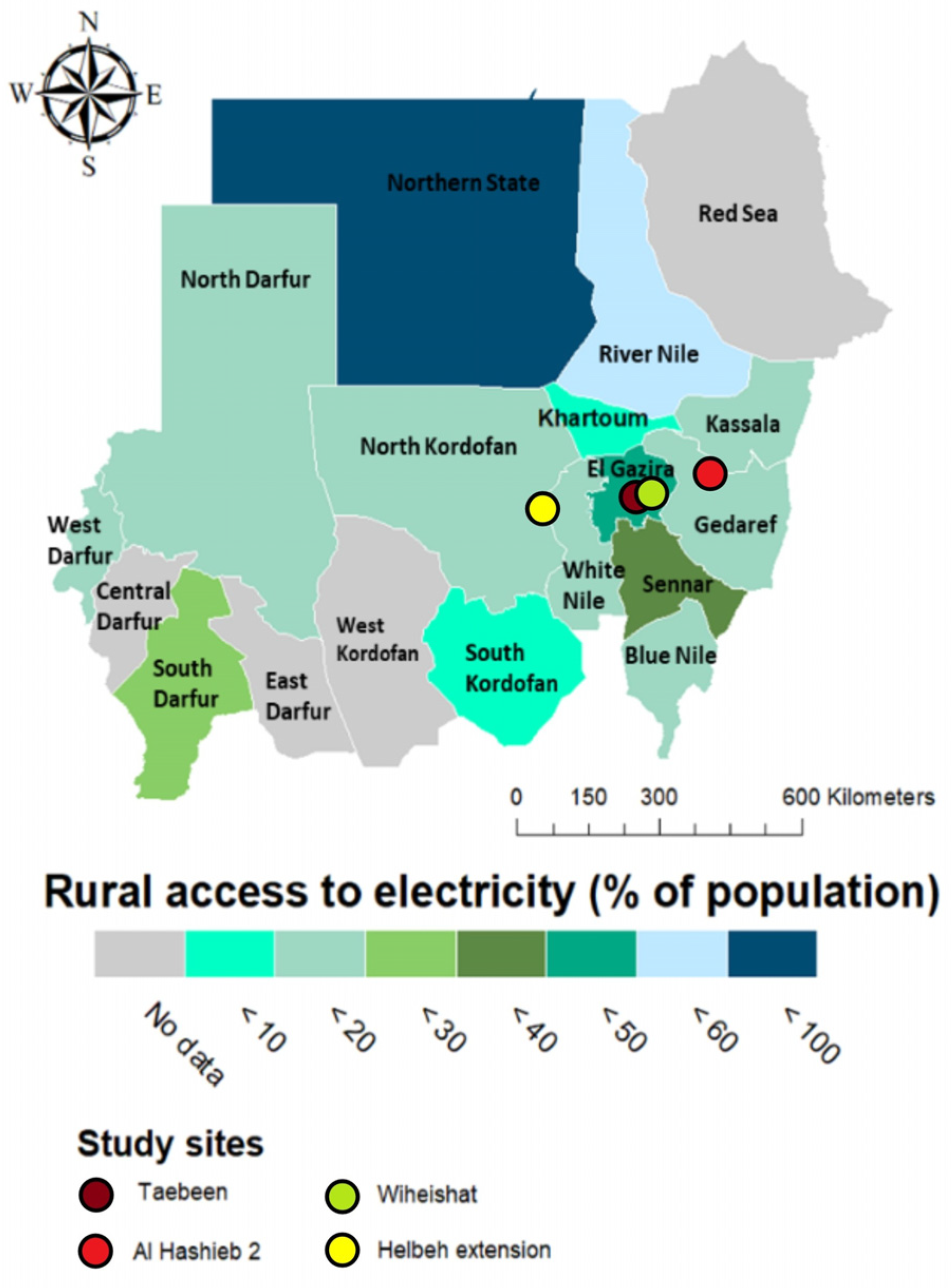
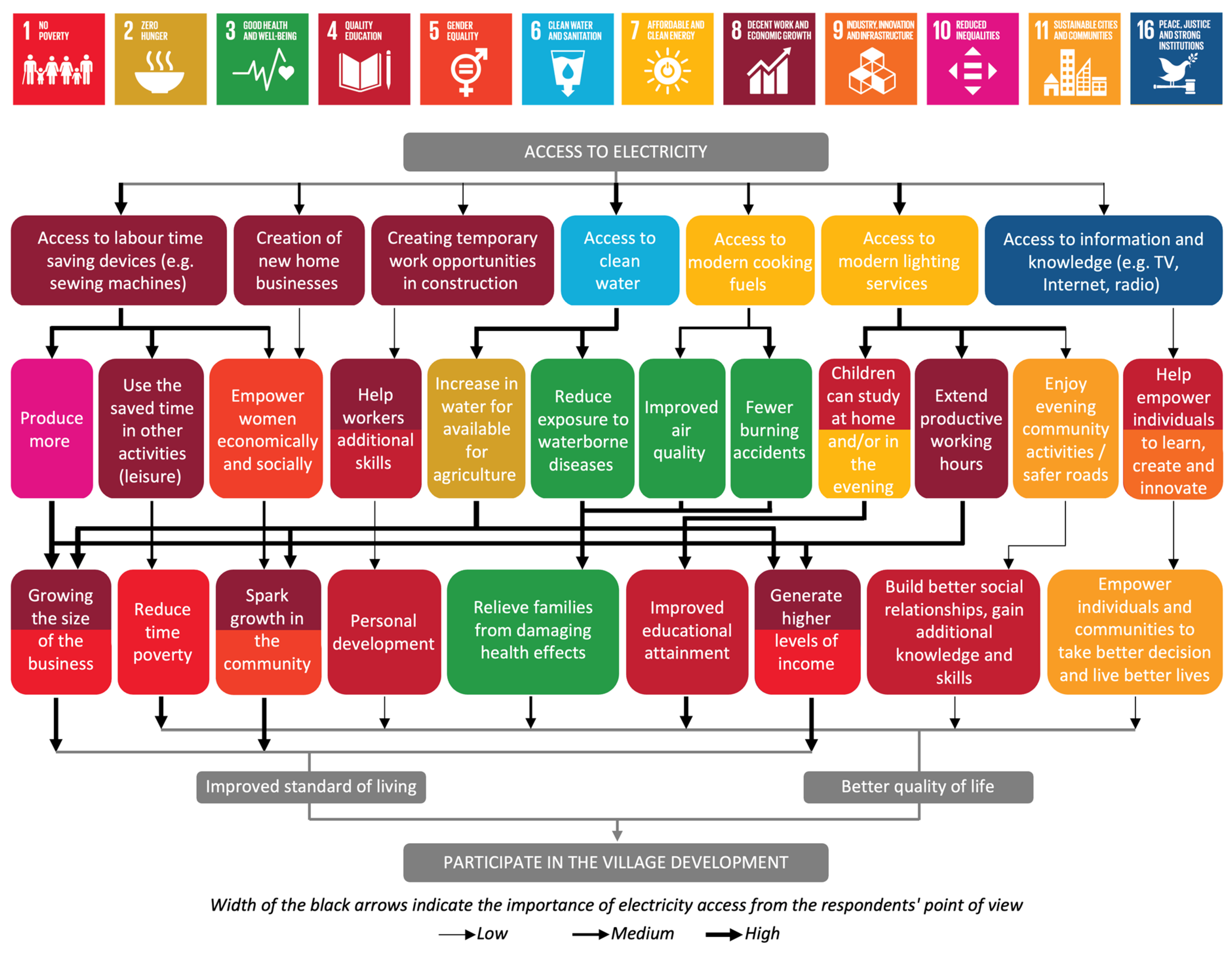
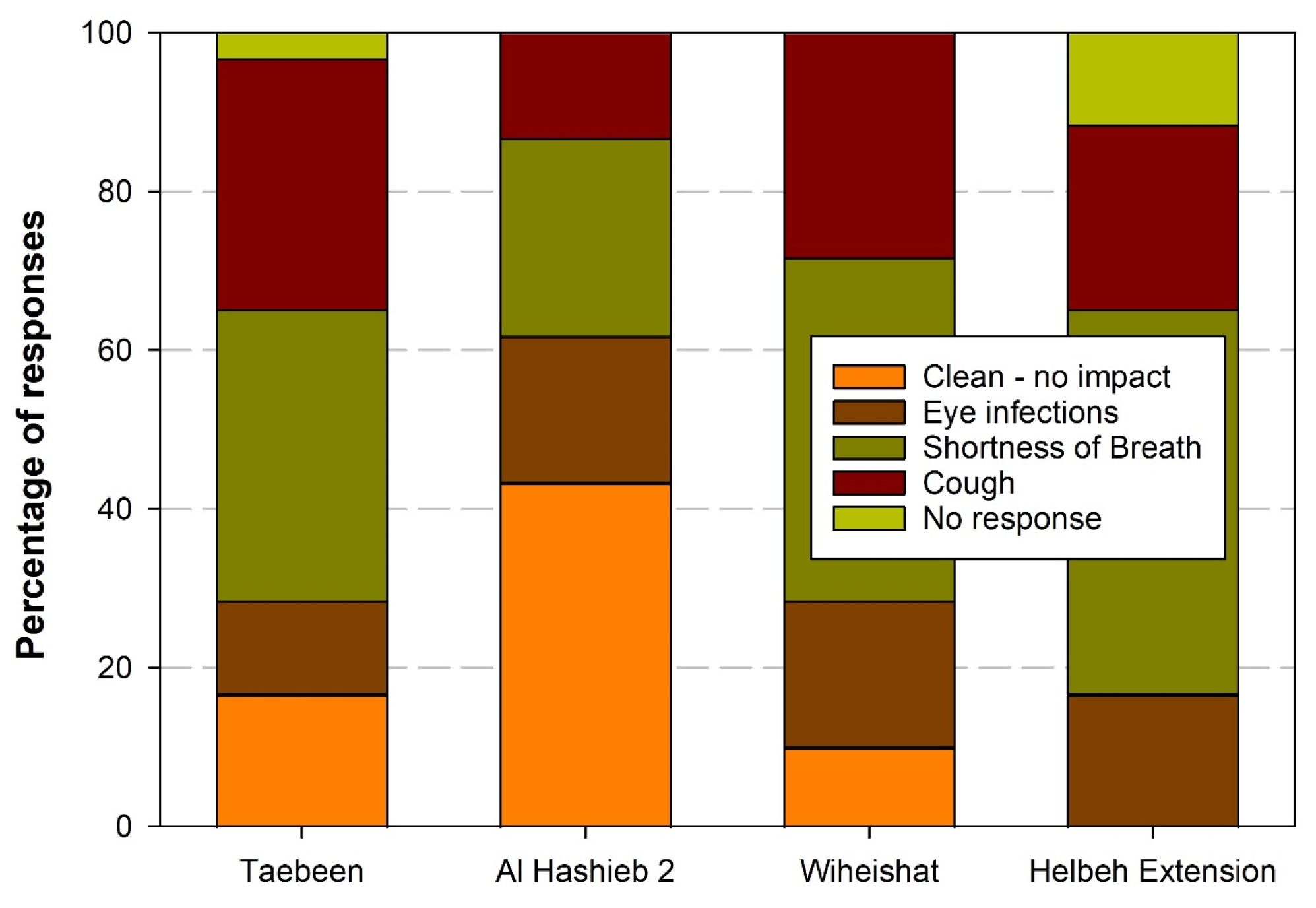
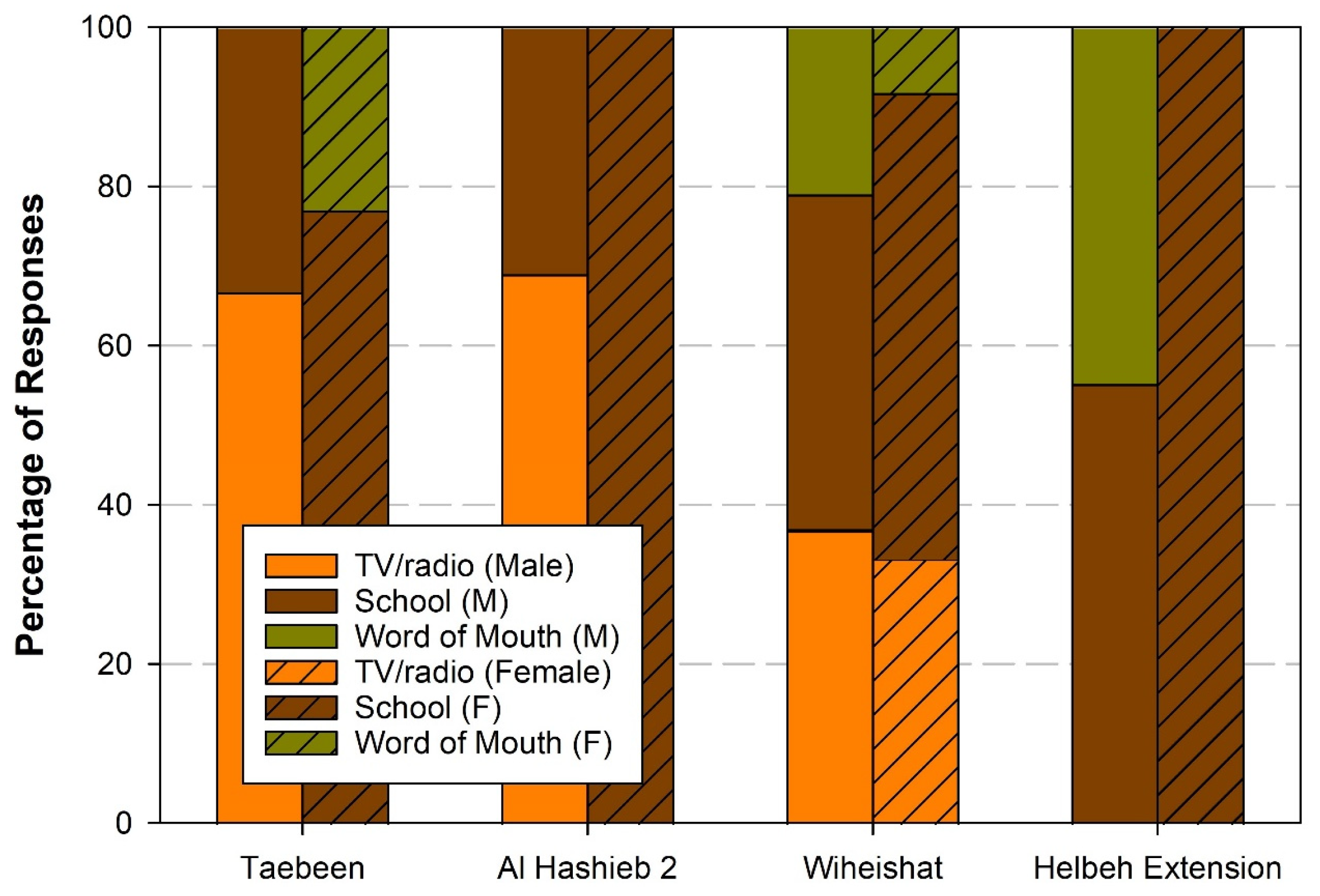
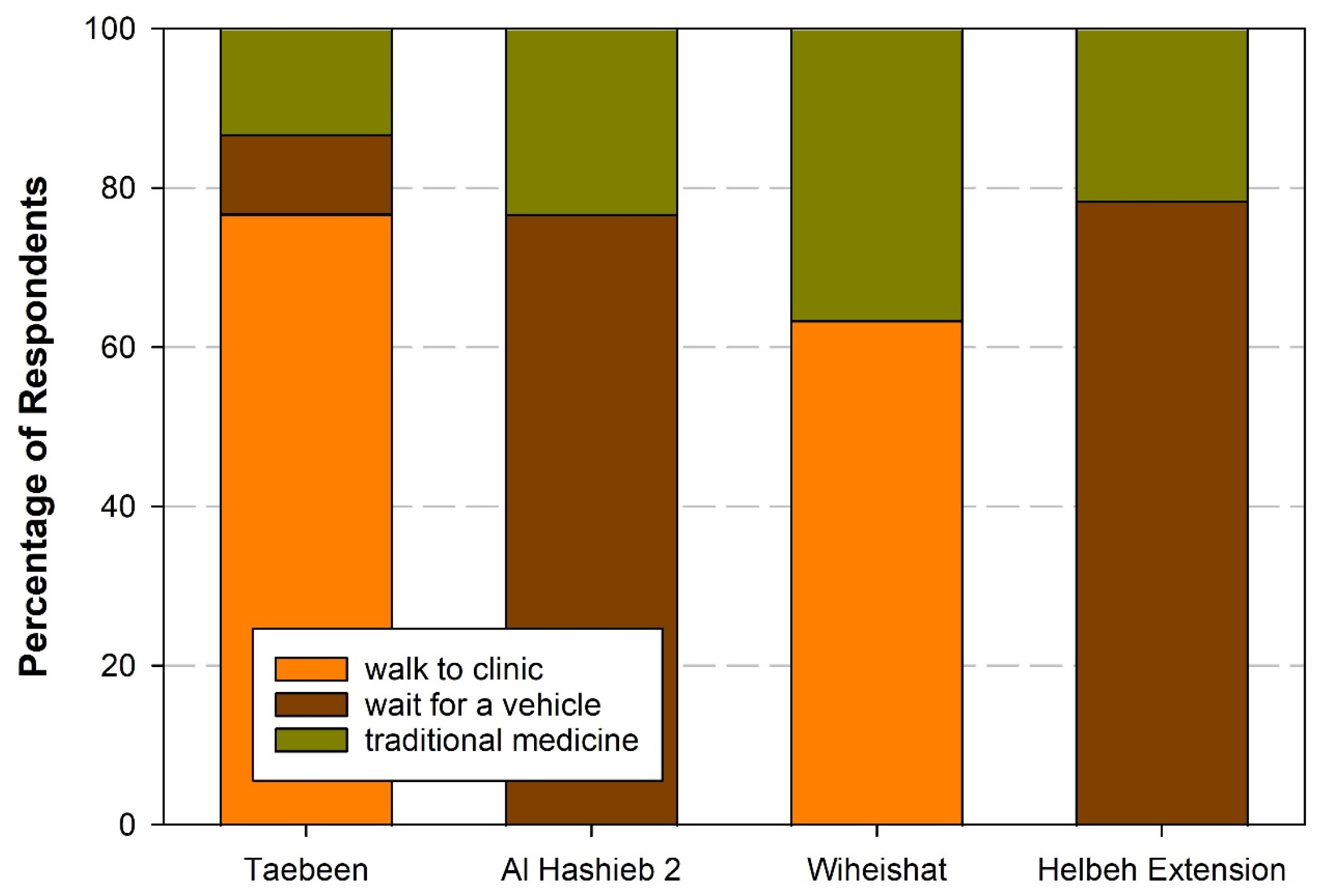
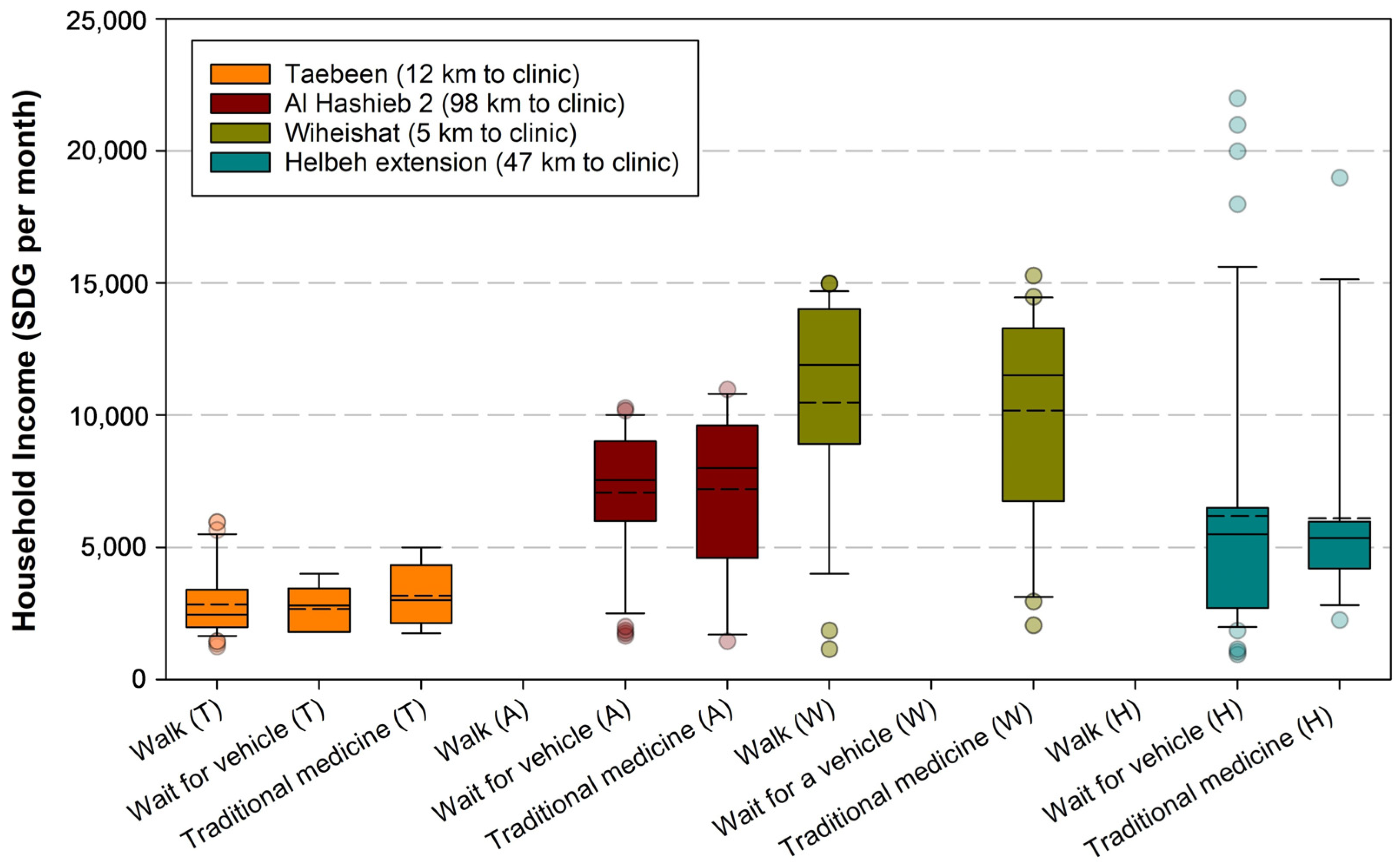
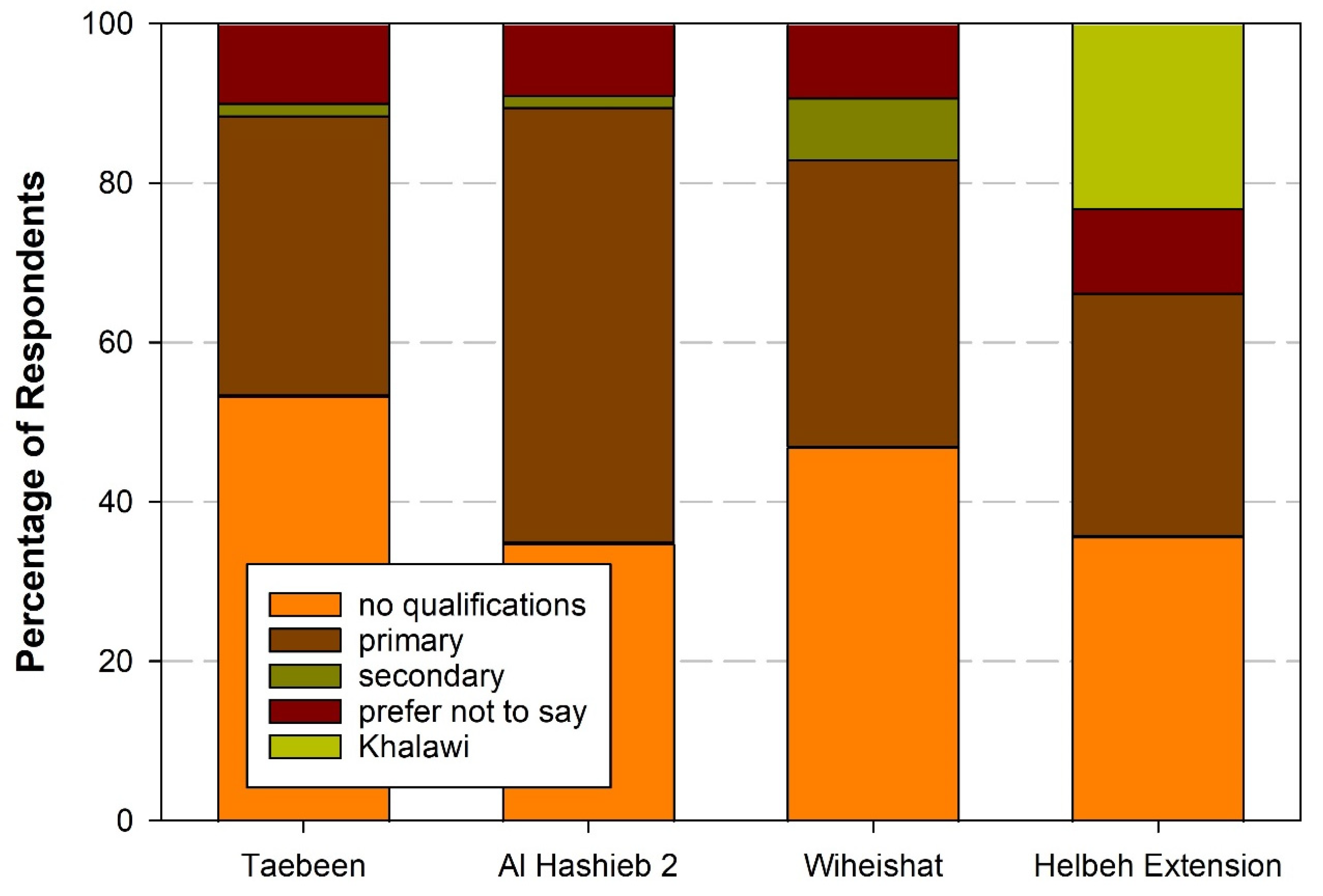
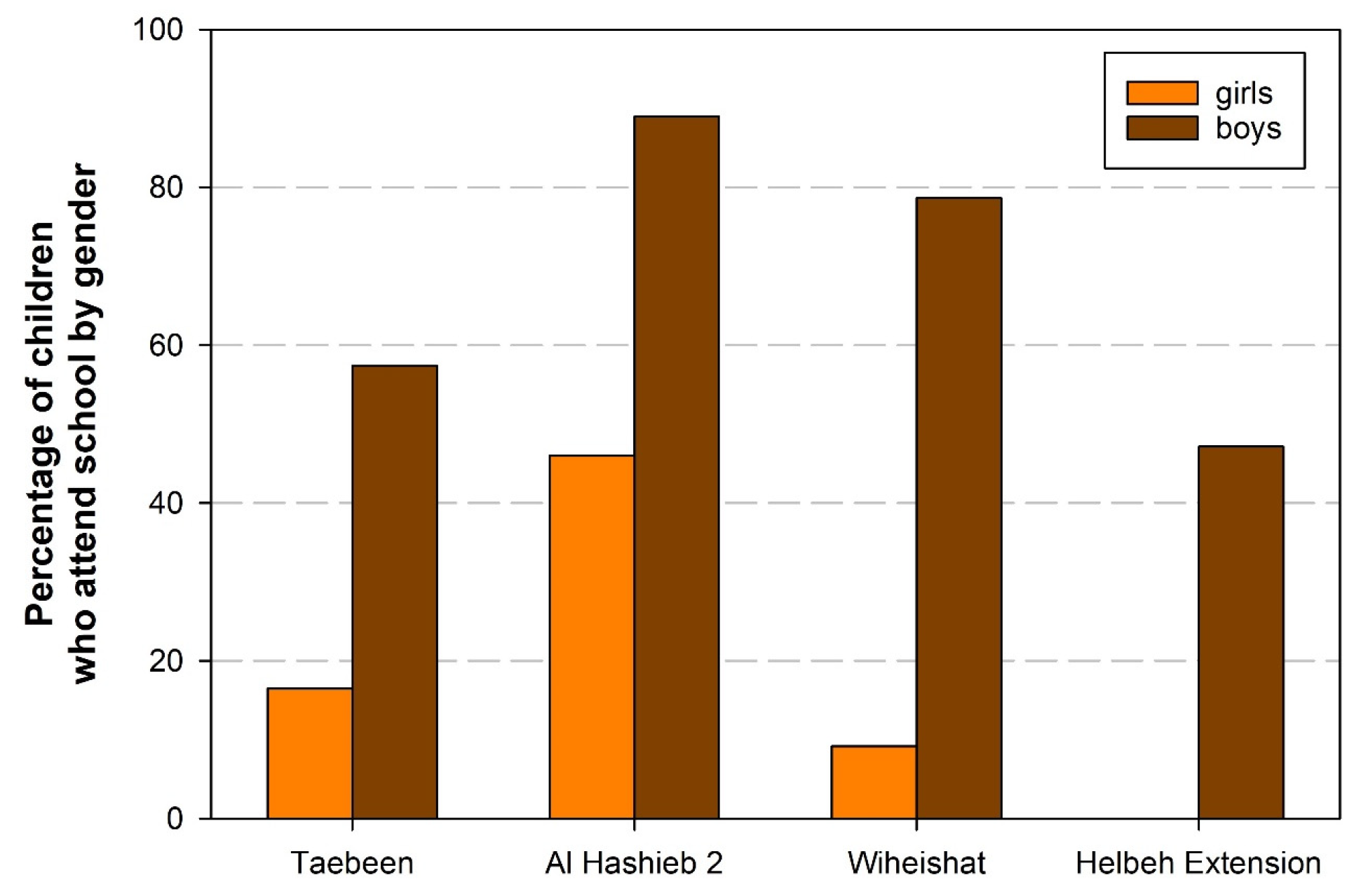
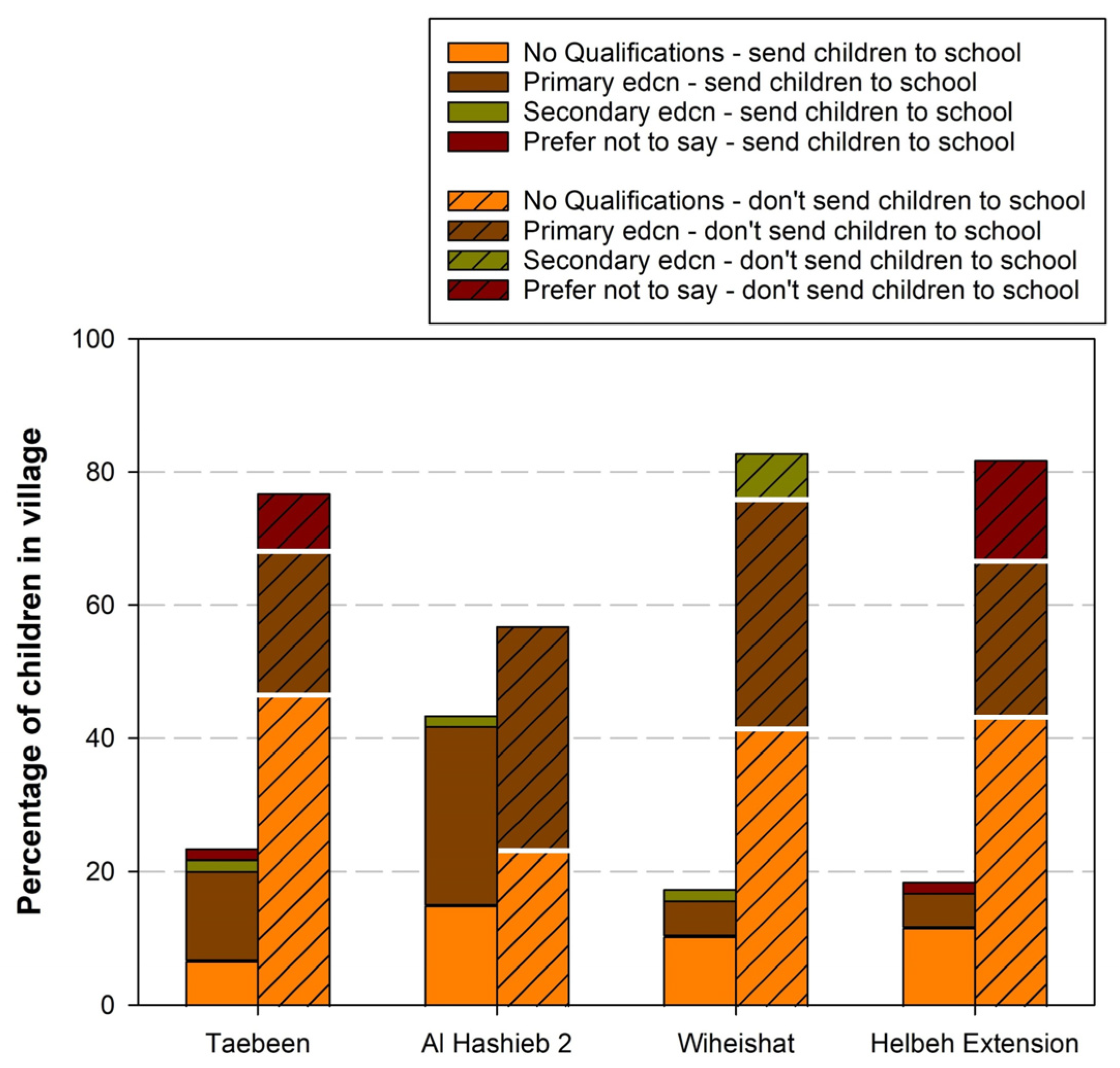
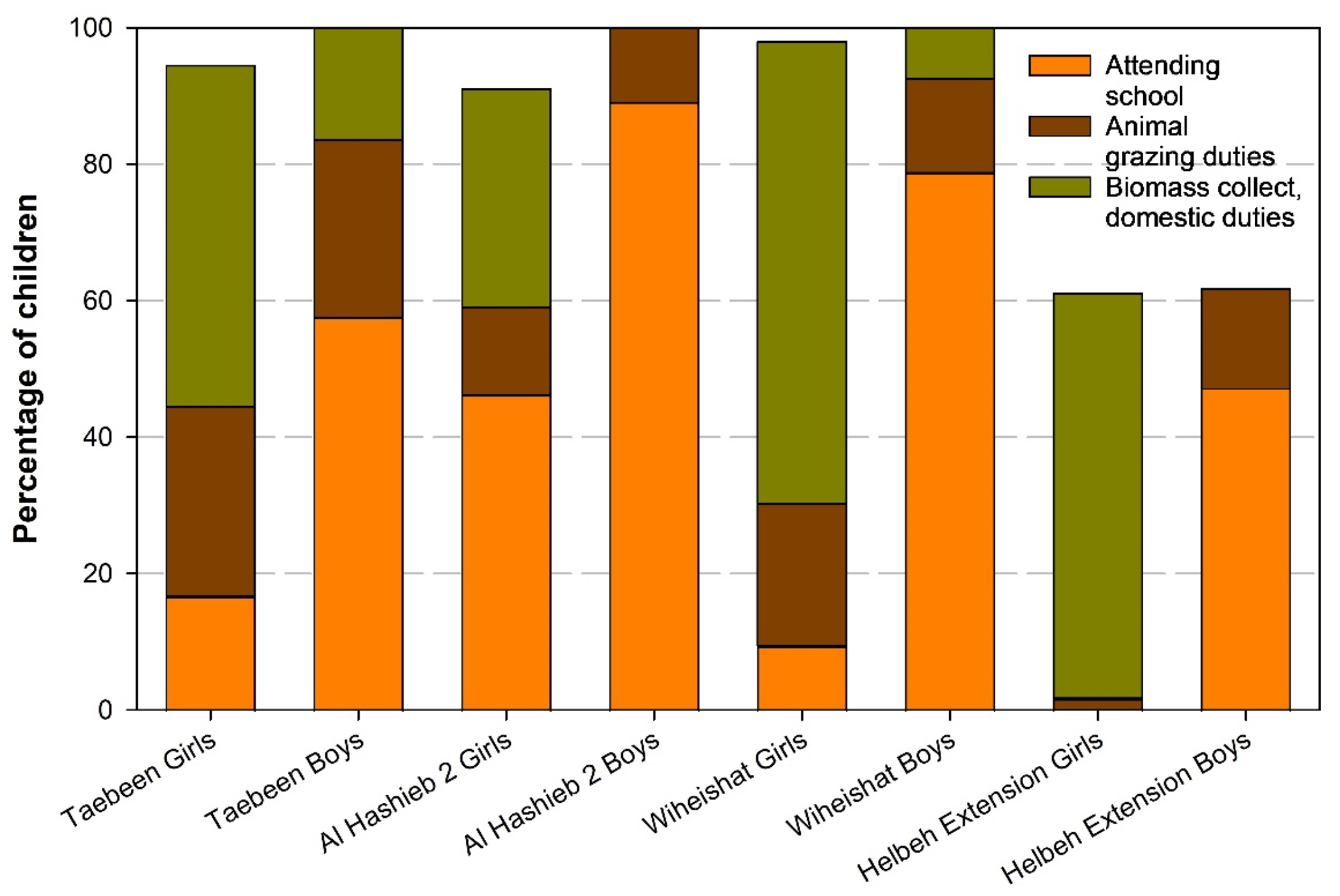
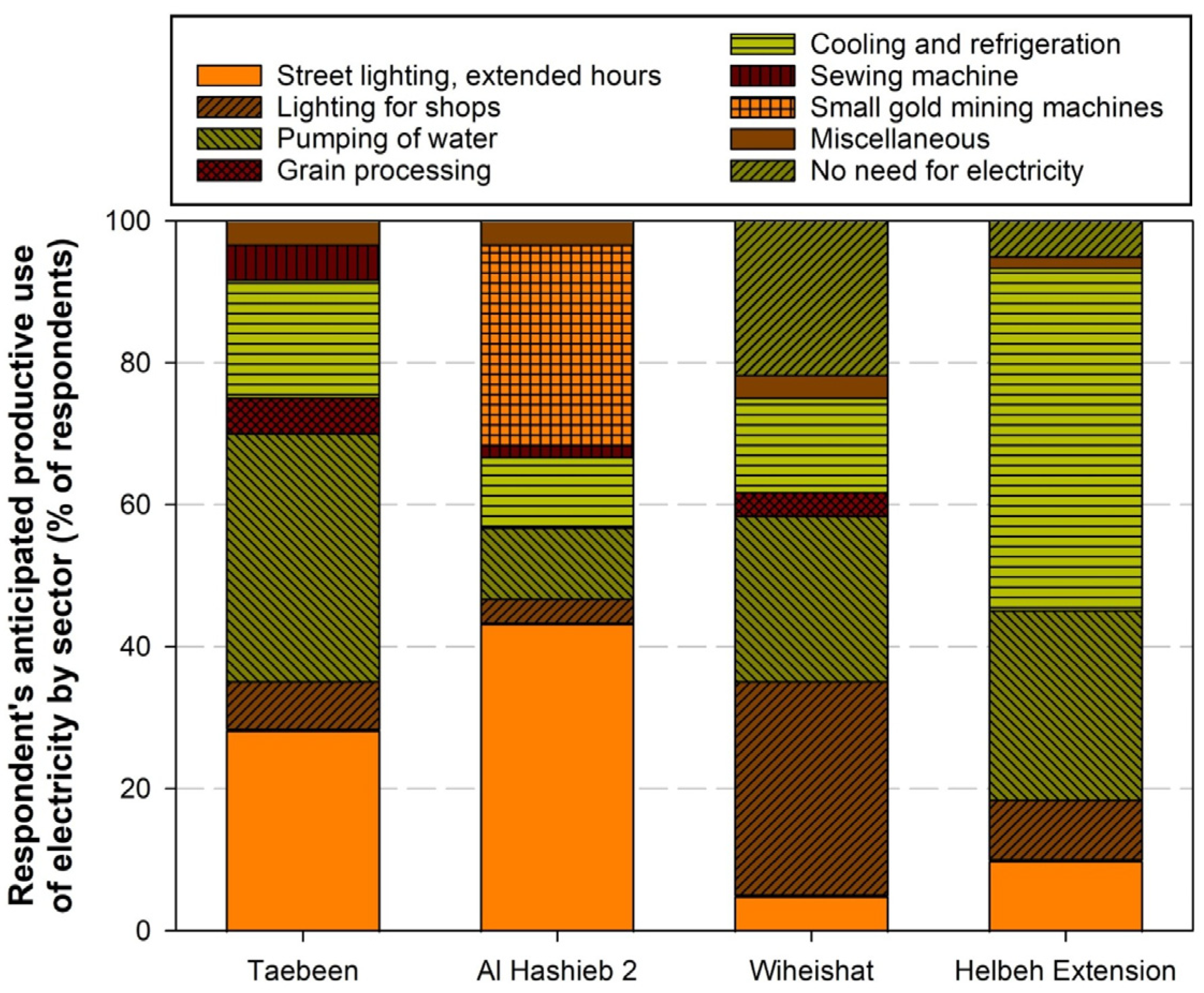
| Description | Taebeen | Al Hashieb 2 | Wiheishat | Helbeh Extension |
|---|---|---|---|---|
| Women | 1 | 1 | 1 | 1 |
| Girls | 1.5 | 1.3 | 1.6 | 1.0 |
| Boys | 1.2 | 1.2 | 1.6 | 1.0 |
| Time spent on household chores (h/day) | 14 | 15 | 13.8 | 13.5 |
| Time spent collecting biomass (h/day) | 5.4 | 5.8 | 7.25 | 4.2 |
| Dependent Variable | Independent Variable | Regression Coefficient | p-Value |
|---|---|---|---|
| All boys in a household attend school | (1) Declared household income | 0.016 | 0.381 |
| (2) Respondent household education level | 0.173 | 0.008 | |
| (3) Number of children in household | 0.053 | 0.007 | |
| (4) Time completing chores | −0.031 | <0.001 | |
| (5) Time collecting biomass | 0.069 | <0.001 | |
| (6) Distance to school | 0.004 | 0.178 | |
| All girls in a household attend school | (1) Declared household income | 0.032 | 0.170 |
| (2) Household head education level | 0.081 | 0.289 | |
| (3) Number of children in household | −0.026 | 0.267 | |
| (4) Time completing chores | −0.025 | <0.001 | |
| (5) Time collecting biomass | −0.052 | 0.014 | |
| (6) Distance to school | −0.011 | <0.001 |
| Independent Variable (Categorical) | Coefficient | Standard Error | Wald Statistic | p Value | VIF | Odds Ratio | 5% Conf. Lower | 5% Conf. Upper |
|---|---|---|---|---|---|---|---|---|
| Constant | −2.679 | 1.061 | 6.373 | 0.012 | 0.069 | 0.009 | 0.549 | |
| Chores Number of hours per day per household | −0.249 | 0.048 | 27.436 | <0.001 | 1.281 | 0.780 | 0.710 | 0.856 |
| Education level No education, prefer not to say (1) Primary (2) Secondary (3) | 0.801 | 0.466 | 2.949 | 0.086 | 1.108 | 2.227 | 0.893 | 5.556 |
| Income Self-reported by household, 9 bands SDG/month 0…2000 (1) ≥2000…<4000 (2) ≥16,000 (9) | 0.030 | 0.114 | 0.071 | 0.790 | 1.026 | 1.031 | 0.824 | 1.289 |
| Number of children Integer value | 0.347 | 0.167 | 4.308 | 0.038 | 1.124 | 1.415 | 1.020 | 1.963 |
| Biomass collection Number of hours per day per household | 0.760 | 0.173 | 19.421 | <0.001 | 1.333 | 2.139 | 1.525 | 3.000 |
| Independent Variable (Categorical) | Coefficient | Standard Error | Wald Statistic | p Value | VIF | Odds Ratio | 5% Conf. Lower | 5% Conf. Upper |
|---|---|---|---|---|---|---|---|---|
| Constant | 0.542 | 0.988 | 0.301 | 0.583 | 1.720 | 0.248 | 11.934 | |
| Chores Number of hours per day per household | −0.108 | 0.051 | 4.455 | 0.035 | 1.443 | 0.897 | 0.812 | 0.992 |
| Education level No education, prefer not to say (1) Primary (2) Secondary (3) | 0.336 | 0.384 | 0.765 | 0.382 | 1.140 | 1.400 | 0.659 | 2.973 |
| Income Self-reported by household, 9 bands SDG/month 0…2000 (1) ≥2000…<4000 (2) ≥16,000 (9) | 0.218 | 0.112 | 3.784 | 0.052 | 1.052 | 1.244 | 0.998 | 1.551 |
| Number of children Integer value | −0.122 | 0.130 | 0.879 | 0.349 | 1.133 | 0.885 | 0.686 | 1.142 |
| Biomass collection Number of hours per day per household | −0.182 | 0.126 | 2.104 | 0.147 | 1.425 | 0.833 | 0.652 | 1.066 |
Disclaimer/Publisher’s Note: The statements, opinions and data contained in all publications are solely those of the individual author(s) and contributor(s) and not of MDPI and/or the editor(s). MDPI and/or the editor(s) disclaim responsibility for any injury to people or property resulting from any ideas, methods, instructions or products referred to in the content. |
© 2025 by the authors. Licensee MDPI, Basel, Switzerland. This article is an open access article distributed under the terms and conditions of the Creative Commons Attribution (CC BY) license (https://creativecommons.org/licenses/by/4.0/).
Share and Cite
Mohammed, A.; James, P.; Bahaj, A. Electricity Access Linkages to Sustainable Development Goals in Rural Sudan. Sustainability 2025, 17, 2441. https://doi.org/10.3390/su17062441
Mohammed A, James P, Bahaj A. Electricity Access Linkages to Sustainable Development Goals in Rural Sudan. Sustainability. 2025; 17(6):2441. https://doi.org/10.3390/su17062441
Chicago/Turabian StyleMohammed, Ayah, Patrick James, and AbuBakr Bahaj. 2025. "Electricity Access Linkages to Sustainable Development Goals in Rural Sudan" Sustainability 17, no. 6: 2441. https://doi.org/10.3390/su17062441
APA StyleMohammed, A., James, P., & Bahaj, A. (2025). Electricity Access Linkages to Sustainable Development Goals in Rural Sudan. Sustainability, 17(6), 2441. https://doi.org/10.3390/su17062441







